Whether you’re trying to spend less money (oh, hey! 👋), eat healthier, get more organized, or just make better use of your time, meal planning can help you get there. I recently released a set of pre-made monthly meal plans, but I think it’s really important to learn how to make a meal plan of your own. Making meal plans tailored to your lifestyle and food preferences will be the most cost effective and reduce the most waste.
And if the thought of meal planning conjures up mental images of spreadsheets, custom day planners, or otherwise makes you want to hide under a blanket and cry, don’t worry. I’ve got a simple formula that will make it so much less intimidating and will allow you to build a plan that works for you and your lifestyle.
This post contains affiliate links. I may receive commissions for purchases made through these links. I only recommend products I personally use or feel would be valuable for you.
How to Make a Customized Meal Plan That Works for YOU
Making a meal plan can be broken down into six simple steps:
- Review your schedule
- Choose your recipes
- Plug the recipes into your schedule
- Make your grocery list
- Shop
- Eat, enjoy, and repeat!
I’ll go into more detail of each step below, describing what you should look for and how to get the most out of your money and time spent. And remember, there is no one size fits all here. Meal planning can be as small as one recipe per week, or as extensive as three meals per day for seven days at a time. It’s up to you, but every little bit of planning WILL pay off.
Step 1 – Review Your Schedule
Before you plan which recipes you’ll be cooking, you need to figure out when you will cook. This will help you determine which style of recipe you will choose for your meal plan.
Take a good look at your schedule and determine not only when you’ll have the time to cook, but also when you’ll have the energy to cook. Whether you only have one day per week, or you have time every night, you can make a meal plan that fits.
Find a few openings in your schedule, block off those times, and make an appointment with yourself to cook. Take the time to actually enter it into your planner or your digital calendar. If it’s actually scheduled, you’re more likely to get it done!
Beginner Tip: Start small! Schedule one recipe your first week, and try two recipes the week after that. Increase the number of recipes each week until you find a balance that fits your lifestyle.
Step 2 – Choose Your Recipes
There are a billion (well, probably 2 billion) recipes on the internet to choose from, so where do you even begin?? Here are a few lifestyle factors that can help you choose which recipes to put in your meal plan:
- Time and Style: Based on your schedule, you may need a specific style of recipe. Do you need quick weeknight dinners? Perhaps a slow cooker recipe that you can have simmering away as you do housework on your day off? Maybe you’re looking for something that makes great leftovers so you can cook once and eat all week? Do you need a One Pot Meal to keep cleanup fast and easy?
- What’s in Your Pantry: Do you have ingredients in your pantry, refrigerator, or freezer that can be used? Browse recipes by ingredient in our Ingredient Index to find recipes that use the ingredients you already have on hand. #reducewaste
- Sales and Seasonality: Check the weekly sale circulars from your grocery stores to see what’s on sale or in season to maximize your grocery budget. Most stores post their weekly sales online, or you can use an app, like Flipp, that aggregates store circulars in one place. Once you know what’s on sale, find recipes for those ingredients by using our Ingredient Index.
Make a list of recipes that you can use in your meal plan(s) based on these factors.
Beginner Tip: The more you meal plan the more “recipe all-stars” you’ll discover. These are recipes that you always look forward to eating, are easy to prepare, and are a good fit for your budget and lifestyle. Keep a running list of these go-to recipes. Once you have 10-15 favorite recipes, meal planning becomes a quick plug-and-play task that only takes minutes.
Step 3 – Plug and Play
Now that you have a list of recipes that you’d like to make, plug them into your schedule in the times you’ve dedicated to cooking.
If cooking every night fits your lifestyle, creating themes for each night of the week can help make sure there is variety in your menu. Once you have your themes, just take recipes from your favorites list and plug them into the appropriate night. Here is a sample week of themes:
- Meatless Monday
- Taco Tuesday
- Take-out Fake-out
- Pasta Night
- Pizza Friday
- Around the World (global flavors)
- Slow Cooker Sunday
Step 4 – Make Your Grocery List
This is probably the step where most people say, “nuh-uh” and go back to spending $$$ on take out. BUT this is where the magic happens and where you’ll save the most moolah. Here’s how it works…
- Go through each recipe in your plan and write down every ingredient and the quantity needed.
- Take that list to your kitchen and cross check it with what’s in your pantry and fridge.
- Go through item by item and cross off everything you already have on hand. This is the most important step! Cross checking your inventory will prevent you from making unnecessary purchases, and will make you aware of staples that need to be restocked. Because there is nothing worse than starting a recipe then realizing you’re out of an ingredient.
- Everything that remains on the list after you cross check your pantry is your final grocery list.
Beginner Tip: If you’re only making one or two recipes, making your grocery list only takes a few minutes, and it gets faster every time. If you have a more ambitious meal plan, there are tons of online tools to make this process easier. My favorite is Plan to Eat (affiliate link), which allows you to save and organize your favorite recipes, plug them into a calendar, and auto-generate grocery lists. Services like this usually carry a small monthly fee, but if the automation gets you over the meal planning hurdle, you’ll be saving ten times more than the few dollars a month it costs for the service.
Step 5 – Shop!
It’s go time! Take your expertly crafted list, put on your blinders, get in, get out, and get it done! You’ll be surprised at how much faster and easier grocery shopping is when you have a concrete plan. If you’re really good you can even divide your grocery list by department to prevent any zig-zagging throughout the store. You’ll feel like a grocery gladiator!
Shopping Options
We live in a modern society with a lot of digital tools to make this step easier and less of a barrier. Shopping and grocery delivery services, like Instacart, Shipt, or Amazon Fresh (affiliate links), can be really helpful, especially if you’re working with an extremely tight schedule. Yes, they do cost more than grocery shopping yourself, but if spending a few dollars up front prevents you from spending huge $$$ on eating out on a daily basis or making a bunch of impulse purchases while you’re at the store, it is so worth it. Many stores also offer online ordering and pick up free of charge.
Step 6 – Cook, Eat, Repeat
You did it! Meal plan complete. Stick with it and each week it will get easier, you’ll plan more, and save more time and money. The little bit of time you put in on the front end will begin to pay off BIG. You’ll be eating awesome food, showing off your cooking skills to your friends, and feeling like you’re really got it together. Because you do.
Will You Just Make a Meal Plan for Me?
If you’re not ready to dive in and do all the work yourself, I do have some pre-made meal plans that can still help. Having a plan, any plan, even if not custom tailored to your life, can still help you save money. Each of the Budget Bytes Meal Plans has four weeks of dinners planned out for you, complete with grocery lists, all in a downloadable pdf recipe book. Read more about the Budget Bytes Meal Plans here!


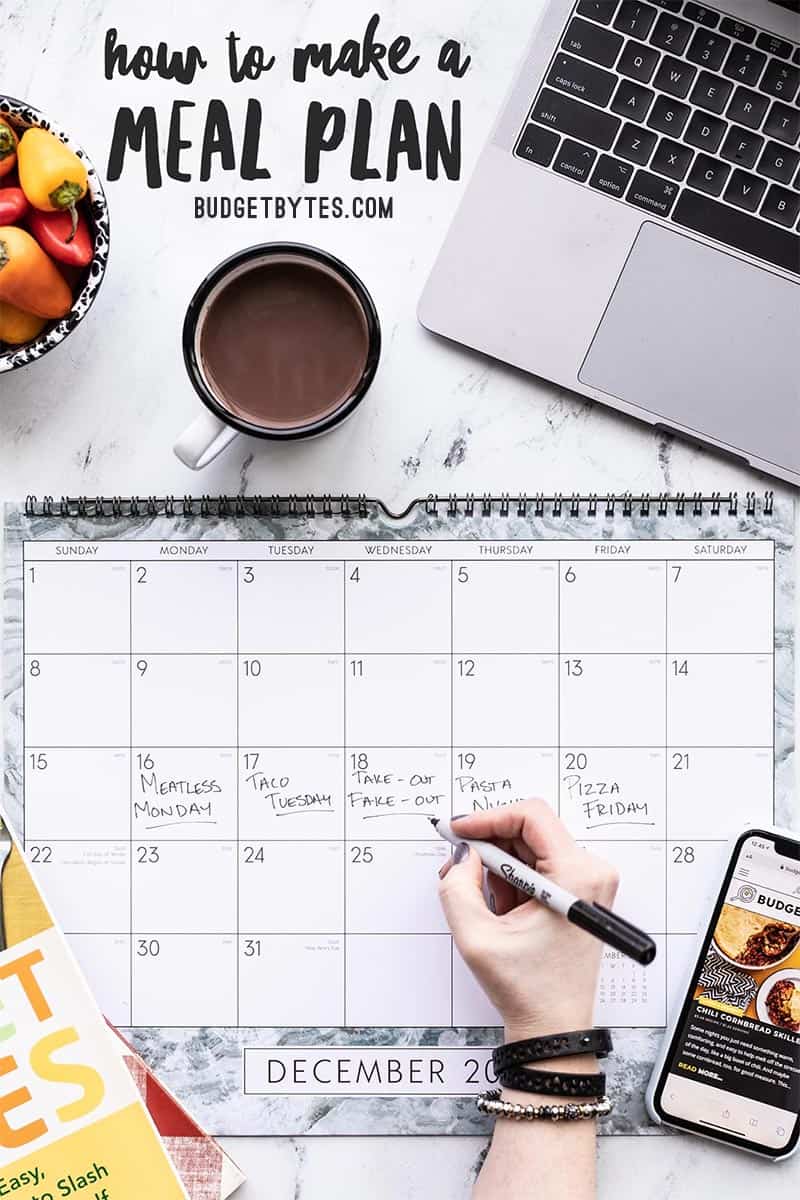
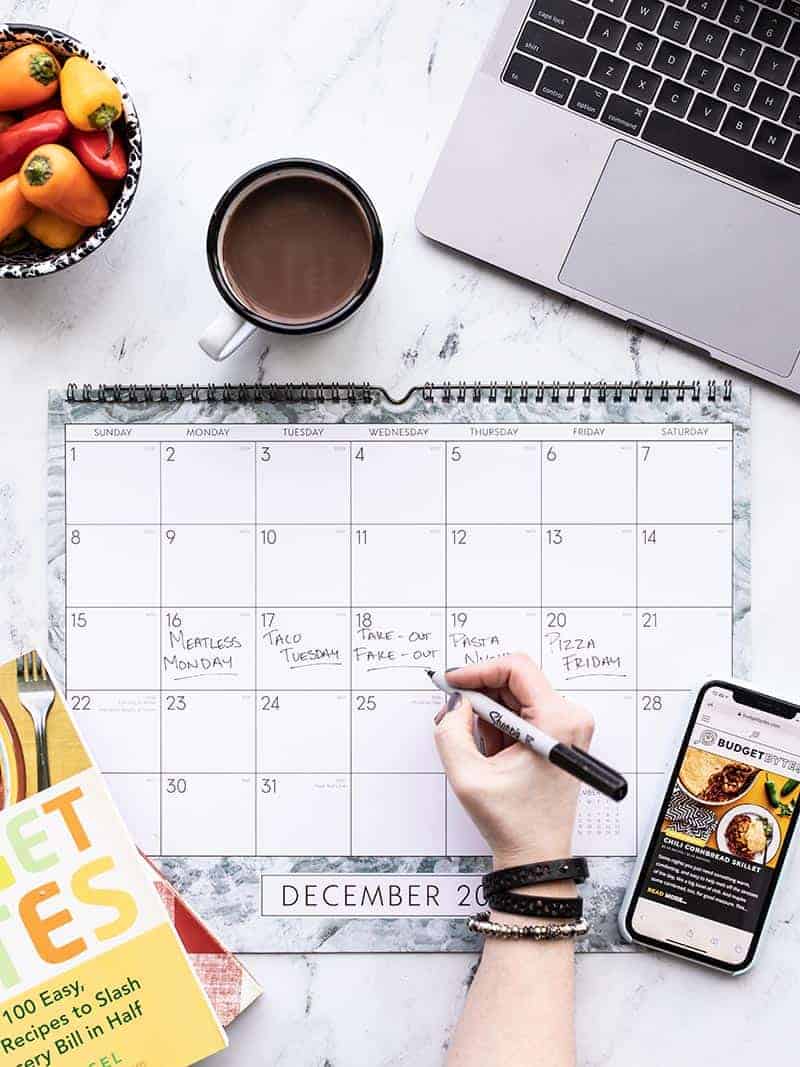
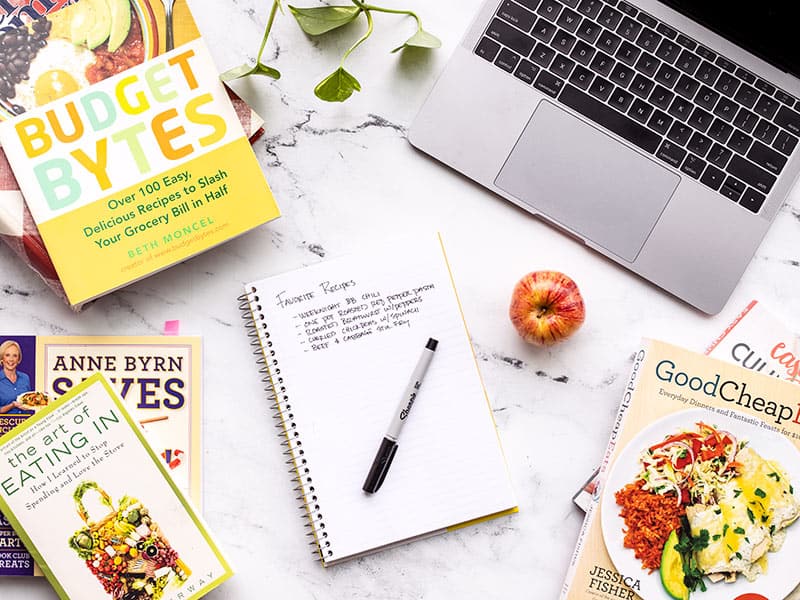

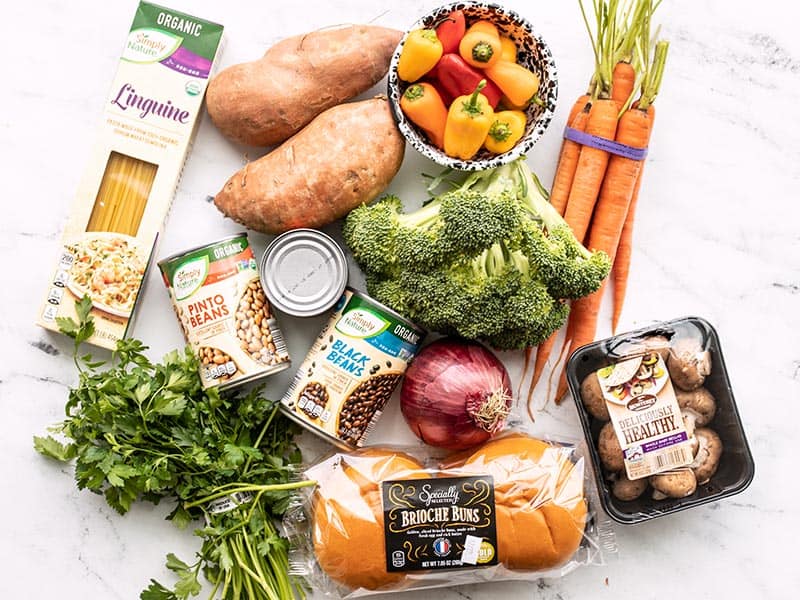
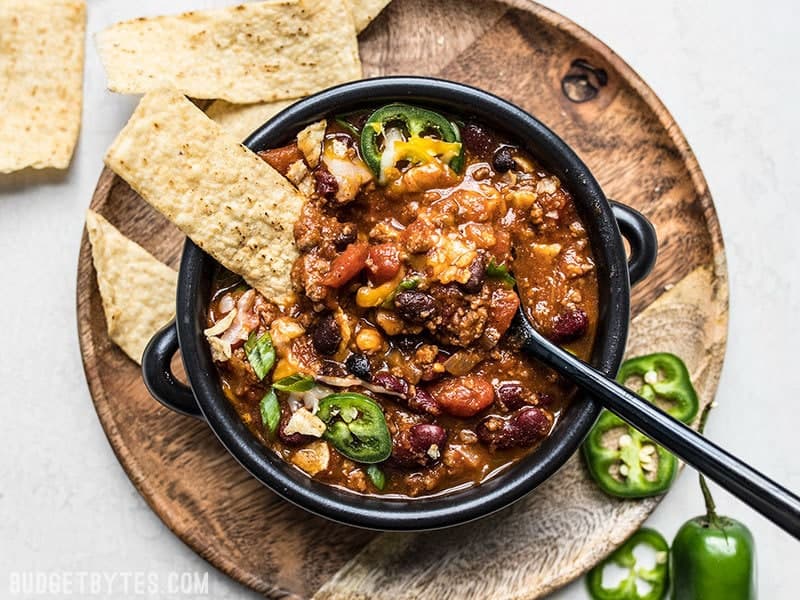

Thank you for this! I’m way too old to start taking this seriously, but better late than never.
Your website and dedication are FANTASTIC!!
I’ m planning to start a healthy meals so i would like you to give advice as a beginner. Thank you very much
Great beginning template for those who are looking and need guidance.
This is a great post! I’m always looking for ways to save money and this is a great way to do it.
Beth, I’m posting a love letter. Besides just your excellent advice about meal planning and prepping, I’m smitten with your relatively simple approach to gourmet food preparation. I’ve learned so much from you in the past few years. And, you’ve saved me a lot of money. Planning + effective shopping + effective storage + great recipes = a successful home food system, and I do mean system. Thank you very, very much.
A few favorites: naan, pita, focaccia rolls, dal nirvana, anything with lentils really, double spinach dip, falafel + hummus, sheet pan anything, granola, homemade versions of staples (e.g. ranch dressing), so many more….
I hope you continue this project for many more years. I echo the words of other comments – you’ve inspired me.
Thank you, Ella! That is the most wonderful compliment ever. :) It makes me happy to know that what I’ve learned just playing around in the kitchen is helpful to others as well!
Sarah up above had good thoughts. Here is how to take meal planning to the next level.
Think ahead. If Mon night is ribeyes (okay, not cheap) and steamed broccoli then chicken and broccoli is good on Tue or Wed and broccoli soup a day or so later. If you roast, broil, or grill chicken make extra for chicken salad and/or chicken tacos. Roast pork loin leftovers sliced thing for sandwiches and then shredded with bottled sauce for BBQ. Dicing or slicing part of an onion? Do it all.
Great, great tips! And meal planning is an excellent way to reduce food waste and lead a more “low to zero waste” lifestyle. I usually plan for three days during the week and leave the other two as leftover/frozen meals days so everything gets eaten. And I do batch cooking on the weekends to enjoy and the excess is frozen. Oh and my garden always has something wonderful to eat like herbs, lettuce, kale and tomatoes (that’s in my salad today).
wow i sure hope it does
This was a great article, right on. One thing that I have been doing for over probably 15 years is I put my grocery list into categories so I’m not scattered all over the place while I shop. For instance, Produce, Meats, Dairy, Grocery, Non-Food. then you’re always in the area where you can find all those meals.
I love the idea of Taco Tuesday or Pizza Friday or Slow Cooker Sunday and for Monday’s meal. The more you can prep ahead, the more you get ahead.
I’m forwarding this post to multiple coworkers who struggle with meal planning. Fabulous advice. I’ve been a long time meal planner and always make sure I have a back up plan for dinners on the nights I’m too lazy to do the “real” meal (although once I started anticipating those days and have a slow cooker meal on queue it got better!) But the ingredients for your bow ties and broccoli are always on hand, and there is always a bag of your frozen bean and cheese burritos for a grab and go lunch. And your site is always the first I look at when searching for new recipes! Thanks for all your hard work!!
Thanks for sharing Adrienne!
I believe the “secret” to this meal planning is called “leftovers” & “Plan B”. Fix it, cook more than 1 serving or x/times servings, eat it or freeze it. BE FLEXIBLE!!! that’s the secret. if you bring it for lunch & get a better offer or not hungry for it, throw it in the freezer, same deal @ home. Please make sure to label the contents & date it. Sure makes for a quick dinner, defrost it, pop it in the microwave, and DONE, DONE!!
“
Couldn’t have said it better ourselves!
i have been feeding a family for 50+ yrs. when i was younger, i took index cards(google it lol) and wrote out all the recipes i knew and liked. i then separated them by ingredient. ie..beef, chicken,pork,veg,pasta,etc.then just laid them out so as to not have the same thing too close together.also, was flexible as in , if making pot roast, i grabbed what was on sale or marked down. we have always had pretty good variety of food on table and we where not well off by any means.
I love it Mary! Thank you for sharing!
Great tips!!! For me, the easiest way to meal plan and cook at home more was to just get used to eating the same dinner for two nights. Then you only have to plan and cook 3 meals a week and you have six days good to go! The seventh day is when I grocery shop and eat out. Pretty much anything from this site is awesome the next day. You might have to double some of the ingredients, depending on how many people you are feeding (we have 3 in our house) but this saves so much effort, time, and money.
Another tip is to utilize store pick up. If you plan carefully ahead of time, you can totally just order everything at most grocery stores now for pick up. Not only does it save you the time of finding everything, but you will also know, for sure, that everything you want is in stock there. And you can take time to analyze prices at home.
Finally- you can get tons of free grocery list apps. A lot of them even integrate digital meal planning. My personal favorite is Any List (I’ve tried many and that one just stuck for me!). I’m to the point now where I can literally plan an entire month ahead of time- the app just captures recipes from the internet and I can throw all the ingredients right on the list from there. Any app takes a little bit of set up at the start, but after about two months you will never look back!
I absolutely cannot LIVE without the store pick up now. We use ClickList here in Colorado. I use it exactly as you are talking about, but I agree that it helps to save me money as I only buy exactly what I need. Now if I can just remember to get dish detergent and the other things more often ;)
@Kelly – Team Budget Bytes. I live in Colorado too and Click List has SAVED me. I no longer have to make myself avoid the snack & ice cream aisles! I just wish they would keep the special where they are waiving the ClickList fee into 2020.
OMG YES! I’ve been abusing that deal for the last few weeks! But I tell the folks there everytime, I’ll GLADLY pay $4.95 because I’d more than likely spend triple that on impulse buys if I were to shop inside!
Love this! I have a couple tips to add –
1) I found out when my grocery store does their “clearance” markdowns (Tuesday morning, before they release the weekly ad on Wednesday). I shop then when everything is freshly marked down and although it’s totally random, meat can be 50-75% cheaper on managers clearance. Then freeze this meat so you can use it in a recipe you plan next week or beyond.
2) I use the shopping list in my grocery store’s app, which sorts everything by aisle and I only have to go through the store once. So efficient!
Meal planning is the best!
These are GOLDEN tips Victoria! Thank you for sharing.
One thing I didn’t see you mention (but may have missed) is planning recipes that lead to little to no waste of ingredients – for example if I shop at Aldi, I know that peppers come in packs of three, so if I plan to make a stir fry one night (1 pepper) then I will also plan fajitas another night (2 remaining peppers) to avoid any waste – that is one of the biggest things I have learned from you! Another thing I find helpful is that if you know you love a certain style of food, one week buy every pantry item you need for that and it opens up a whole new realm of recipes (for example – I bought oyster sauce, sesame oil, rice vinegar, and now I can make all sorts of asian recipes!). I’m also a big fan of breakfast for dinner once a week because it’s so delicious and cheap and one night of a stir fry at the end of the week to use up straggler vegetables. I have learned SO much from you and it’s crazy how reducing meat can help my budget – you definitely taught me that!
I pick 4-7 recipes per week depending on what we have going on and then just write them on a small white board on my fridge. Then I just cross off whatever we decide to have that day rather than locking in certain recipes for certain days. I need that flexibility. I also list what fruit we have on hand so it’s not forgotten and sometimes lunch stuff or Sunday breakfast if it’s not our typical.
That’s a great tip Nic!
I don’t mean to reply to this thread. Oops. >_<
Yes! I didn’t really see that as a tip but you’re so right. When I buy bell peppers at Aldi, or bagged spinach, I always am sure to include another recipe to use up the remaining ingredients. When I buy buttermilk, we have like two weeks of eating biscuits, cinnamon rolls, regular rolls, and all things buttermilk until it’s gone.
Having Beth’s sriracha hummus on hand is another great way to use up peppers!
Wonderful ideas. It’s easy to sign up online to the supermarkets in your area so the weekly specials land in your email every week, usually Wednesday. Specials often sell out over the weekend, so I shop on Thursday or wait for Monday or Tuesday to be sure they are restocked. You can ask at customer service to find out when trucks deliver. I scan specials on Wednesday evening–about 10 minutes to go through those that interest me (don’t forget Aldi’s), and then a few minutes to think about what we like, and check pantry and freezer to check what’s on hand.
I always liked to shop early, but have changed that habit at my favorite supermarket to let them stock, get the fresh bread to the bakery station, open customer service at the butcher counter, etc. I do organize my list by my path through the store, and I can get through a big supermarket in about 20 minutes, Aldi’s in 10. I rarely shop more than one any given week because time is money, too–although Fresh Market often has bargain promotions on the weekend, and it’s easy to fly in to grab an item or two.
I don’t have my meal plan set in concrete when I shop–I sometimes see something not on the flyer that looks fresh and delicious, or find an unexpected bargain that prompts me to be flexible. I’m not talking big changes–it might be that the planned green beans look weary, and a pile of zucchini is marked down.
I do forward planning. Ie, Aldi’s often sells large packages of boneless chicken breast for $1.69 a lb–I buy a big package, hold out one breast, and bag all the rest individually and put in the freezer to use over several weeks. Those chicken pieces are usually close to 1 lb each. Same with meat bargains elsewhere. I got an extra boneless turkey breast last month for $1.39 per lb and will smoke it for Christmas dinner next week. Always cramped for freezer space, nothing stays in there very long
These are amazing tups for beginners! Doing this has simplified our lives so much!
Paige
http://thehappyflammily.com
Thanks Paige!
Budget Bytes is the reason I’m able to actually eat well every day on a small income. I haven’t tried the suggested meal plans but by trying out Budget Bytes’ recipes, I’ve definitely been able to become better at meal planning and cutting down on how much I spend on food as well as food waste. Seriously, I have no idea what I’d be doing without this blog and the cookbook. But I do definitely need to compile a list of favorite recipes to get my meal planning process more streamlined!
I’d also add a tip to plan one meal a week using ONLY pantry staples, shelf stable, or frozen ingredients. That way, if something happens and you have to drop a meal from your plan, you don’t have fresh ingredients that may go bad.
That’s really smart, Eleanor!
Great idea Eleanor!
Love this! As much as I’d love to be able to perfectly complete a meal plan, life always happens and I usually have to re-configure a little something during the week. To account for this, I do something similar to you – I make one big batch of soup at the beginning of the month, freeze it into portions, and schedule it for one meal per week. Just as you said, if I need to drop a meal from the plan, nothing gets wasted because I can leave that bowl in the freezer for next week! Alternatively, if I get home from work one night and have run completely out of energy, I can thaw a bowl of soup and move that night’s meal to the next day without upsetting everything too much.
Such a useful idea!
One thing I would add is to check your supermarket’s weekly specials somewhere in this process–most likely as you decide on meals and check your pantry. Once you begin to develop a set of reliable go-to recipes, you can let specials help guide your meal planning. Beth, you’ve inspired me to be even more deliberate about my planning! Thanks for the guide!
Well, gosh, now I see that you did mention this, up in step 1. Silly me for not reading closely enough. I should have know you’d add that! :-)
Yes definitely check those specials!